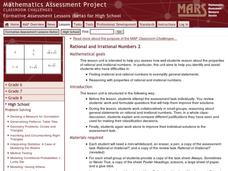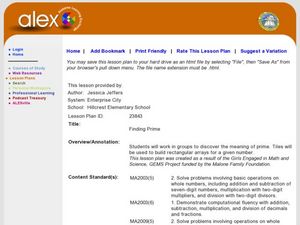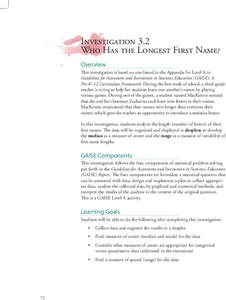Curated OER
Rational and Irrational Numbers 2
Is the circumference of a circle always, sometimes, or never rational? Learners answer questions individually and also work in groups to look at sums and products of rational and irrational numbers. They must also be able to use the...
National Security Agency
A Balancing Act: Solving Multi-Step Equations
Wow! Put on that thinking cap and solve multi-step equations. To solve equations, learners review the use of the distributive property and combining like terms. This three-day lesson comes with about 20 pages of worksheets, warm-ups,...
Alabama Learning Exchange
Finding Prime
Fifth and sixth graders explore prime numbers. They work with a partner to build rectangular arrays using twelve tiles. Factor pairs are noted and recorded on graph paper. Pupils construct rectangular arrays with a prime number and...
Curated OER
Sums and Difference of Cubes
Learners factor polynomials using the sum and difference of cubes. They also learn connections between the graph and expression.
Curated OER
Trig Transformations
Learners investigate trigonometric function. In this Algebra II lesson, students explore functional notation and transformational graphing of trigonometric functions.
Curated OER
Dilations in the Plane
Tenth graders investigate dilations and explore the dilation transformation before investigating the properties of a dilation using Cabri Jr. High schoolers extend the concept of dilatation to the coordinate plane.
Texas Instruments
Is It or Isn't It Proportional
How can you tell if number relationships are proportional? Mathematicians investigate proportional relationships. They compare and contrast functions and graphs to determine the characteristics of proportional relationships, as well as...
American Statistical Association
Who Has the Longest First Name?
Name that statistic! Classmates each write their name and the number of letters in it on a sticky note to place on the board. As a class, they determine the median, mode, and range of the name lengths, and create a dot plot of the data....
American Statistical Association
The Gumball Machine
Chew on an activity for probability. Given information on the number of gumballs in a gumball machine, scholars consider how likely it is to randomly draw a blue gumball and how many of each color they would draw in 10 trials if the...
Flipped Math
Unit 6 Review: Similar Figures
After a short review of the material from the Similar Figures Unit, pupils work through 18 problems to further practice the skills from the unit. Scholars apply those skills in the application problems at the end of the review.
Flipped Math
Side Splitter Theorem
Apply perspective to similarity. Individuals learn about the Side Splitter Theorem by looking at perspective drawings. Pupils use the theorem and its corollary to find missing lengths in figures. Next, they practice using the theorem and...
Flipped Math
Prove Triangles Similar
Show more than one way to prove similarity. Scholars learn three different methods to show two triangles are similar, Angle-Angle, Side-Side-Side, and Side-Angle-Side. Pupils practice applying these methods to determine whether two given...
Flipped Math
Unit 3 Review: Parallell and Perpendicular Lines
Learners watch a quick review on the Parallel and Perpendicular Lines unit. The pupils work through ten review problems ranging from identifying types of angles formed by parallel lines and transversals to writing equations of parallel...
Flipped Math
Proving Lines Parallel
Show it can all be proved. Scholars learn the converses of the properties of parallel lines. Using the converses, pupils determine which lines are parallel based on angle measurements and practice using a flow proof to show that two...
Flipped Math
Properties of Parallel Lines
Work within a parallel universe. Scholars learn about the relationships of angles when two parallel lines are intersected by a transversal. They see how to find the measurements of all eight angles by knowing the measure of one angle....
Flipped Math
Unit 2 Review: Reasoning and Proofs
The proof is in the review. Individuals watch a short review of the content from the unit to prepare for the unit exam. The review covers inductive reasoning, conditional and related statements, and two-column algebraic and geometric...
Flipped Math
More with Proofs
Proofs may be as easy as 1, 2, 3 ... maybe. Pupils participate in creating four example proofs. The presentation uses a list of geometric properties to develop the proofs by filling in both the statements and reasons. Scholars practice...
Flipped Math
Intro to Proofs
Prove the best way to keep up in Geometry. Scholars first review algebraic properties from Algebra. Learners then use the properties to create two-column proofs to solve linear equations before completing algebraic proofs by providing...
Flipped Math
Addition Postulate
Add a little algebra to the geometry. Class members learn about the Addition Postulate for segments and angles. The pupils use their knowledge of solving equations to find lengths of segments and measures of angles. Individuals apply...
Flipped Math
Angle Pairs
Complement the class by identifying pairs of angles. With a vocabulary lesson, pupils learn the names and definitions of special angle pairs including adjacent, vertical, complementary, supplementary, and linear pairs. Using the...
Flipped Math
Points, Lines, and Planes
Geometry is more than just vocabulary. Pupils learn the basic geometric definitions and how to identify and name points, lines, and planes. Though the first lesson is packed with related vocabulary, scholars experience four postulates...
Utah Education Network (UEN)
Expressions and Equations
Variables may be unknown, but expressions and equations are easy to understand. Pupils learn to write, evaluate, and simplify numeric and algebraic expressions. They also investigate how to write and solve simple equations and...
Utah Education Network (UEN)
Geometry
Shape one's understanding of geometry using the resource. The sixth of seven chapters in 6th Grade Math focuses on geometry principles. Future mathematicians learn to find the area of parallelograms, trapezoids, triangles, and other...
Utah Education Network (UEN)
Statistics
Find the value in analyzing data values. Statistics is the focus in the fifth of seven installments of the 6th Grade Math series. Individuals learn to examine dot plots, histograms, and box plots by considering the shape, mean, median,...

























